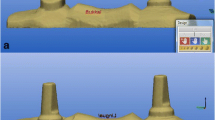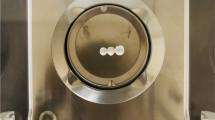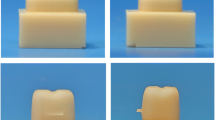Abstract
This study investigated the influence of the elastic modulus of supporting dies on the fracture strengths of all-ceramic materials used in dental crowns. Four different types of supporting die materials (dentin, epoxy resin, brass, and stainless steel) (24 per group) were prepared using a milling machine to simulate a mandibular molar all-ceramic core preparation. A total number of 96 zirconia cores were fabricated using a CAD/CAM system. The specimens were divided into two groups. In the first group, cores were cemented to substructures using a dual-cure resin cement. In the second group, cores were not cemented to the supporting dies. The specimens were loaded using a universal testing machine at a crosshead speed of 0.5 mm/min until fracture occurred. Data were statistically analyzed using two-way analysis of variance and Tukey HSD tests (α = 0.05). The geometric models of cores and supporting die materials were developed using finite element method to obtain the stress distribution of the forces. Cemented groups showed statistically higher fracture strength values than non-cemented groups. While ceramic cores on stainless steel dies showed the highest fracture strength values, ceramic cores on dentin dies showed the lowest fracture strength values among the groups. The elastic modulus of the supporting die structure is a significant factor in determining the fracture resistance of all-ceramic crowns. Using supporting die structures that have a low elastic modulus may be suitable for fracture strength tests, in order to accurately reflect clinical conditions.




Similar content being viewed by others
References
Snyder MD, Hogg KD (2005) Load-to-fracture value of different all-ceramic crown systems. J Contemp Dent Pract 6:54–63
Pröbster L, Diehl J (1992) Slip-casting alumina ceramics for crown and bridge restorations. Quint Int 23:25–31
Harrington Z, McDonald A, Knowles J (2003) An in vitro study to investigate the load at fracture of Procera AllCeram crowns with various thickness of occlusal veneer porcelain. Int J Prosthodont 16:54–58
AL-Makramani BM, Razak AA, Abu-Hassan MI (2008) Evaluation of load at fracture of Procera AllCeram copings using different luting cements. J Prosthodont 17:120–124
Beschnidt SM, Strub JR (1999) Evaluation of the marginal accuracy of different all-ceramic crown systems after simulation in the artificial mouth. J Oral Rehabil 26:582–593
Riley EJ (1977) Ceramo-metal restoration. State of the science. Dent Clin North Am 21:669–682
Josephson BA, Schulman A, Dunn ZA, Hurwitz W (1991) A compressive strength study of complete ceramic crowns. Part II. J Prosthet Dent 65:388–391
Miller A, Long J, Miller B, Cole J (1992) Comparison of the fracture strengths of ceramometal crowns versus several all-ceramic crowns. J Prosthet Dent 68:38–41
Yoshinari M, Dérand T (1994) Fracture strength of all-ceramic crowns. Int J Prosthodont 7:329–338
Sobrinho LC, Cattell MJ, Knowles JC (1998) Fracture strength of all-ceramic crowns. J Mater Sci Mater Med 9:555–559
Scherrer SS, de Rijk WG (1993) The fracture resistance of all-ceramic crowns on supporting structures with different elastic moduli. Int J Prosthodont 6:462–467
Rosenstiel SF, Land MF, Crispin BJ (1998) Dental luting agents: a review of the current literature. J Prosthet Dent 80:280–301
Tsai YL, Petsche PE, Anusavice KJ, Yang MC (1998) Influence of glass-ceramic thickness on Hertzian and bulk fracture mechanisms. Int J Prosthodont 11:27–32
Campbell SD (1989) A comparative strength study of metal ceramic and all-ceramic esthetic materials: modulus of rupture. J Prosthet Dent 62:476–479
Sarafianou A, Kafandaris NM (1997) Effect of convergence angle on retention of resin-bonded retainers cemented with resinous cements. J Prosthet Dent 77:475–481
Cho L, Song H, Koak J, Heo S (2002) Marginal accuracy and fracture strength of ceromer/fiber-reinforced composite crowns: effect of variations in preparation design. J Prosthet Dent 88:388–395
Burke FJ (1995) The effect of variations in bonding procedure on fracture resistance of dentin-bonded all-ceramic crowns. Quintessence Int 26:293–300
Pagniano RP, Seghi RR, Rosenstiel SF, Wang R, Katsube N (2005) The effect of a layer of resin luting agent on the biaxial flexure strength of two all-ceramic systems. J Prosthet Dent 93:459–466
Lee SK, Wilson PR (2000) Fracture strength of all-ceramic crowns with varying core elastic moduli. Aust Dent J 45:103–107
Bindl A, Lüthy H, Mörmann WH (2006) Strength and fracture pattern of monolithic CAD/CAM-generated posterior crowns. Dent Mater 22:29–36
Hwang JW, Yang JH (2001) Fracture strength of copy-milled and conventional In-Ceram crowns. J Oral Rehabil 28:678–683
Preuss A, Rosentritt M, Frankenberger R, Beuer F, Naumann M (2008) Influence of type of luting cement used with all-ceramic crowns on load capability of post-restored endodontically treated maxillary central incisors. Clin Oral Investig 12:151–156
Akesson J, Sundh A, Sjögren G (2009) Fracture resistance of all-ceramic crowns placed on a preparation with a slice-formed finishing line. J Oral Rehabil 36:516–523
Wood KC, Berzins DW, Luo Q, Thompson GA, Toth JM, Nagy WW (2006) Resistance to fracture of two all-ceramic crown materials following endodontic access. J Prosthet Dent 95:33–41
AL-Makramani BM, Razak AA, Abu-Hassan MI (2009) Comparison of the load at fracture of Turkom-Cera to Procera AllCeram and In-Ceram all-ceramic restorations. J Prosthodont 18:484–488
Webber B, McDonald A, Knowles J (2003) An in vitro study of the compressive load at fracture of Procera AllCeram crowns with varying thickness of veneer porcelain. J Prosthet Dent 89:154–160
Zahran M, El-Mowafy O, Tam L, Watson PA, Finer Y (2008) Fracture strength and fatigue resistance of all-ceramic molar crowns manufactured with CAD/CAM technology. J Prosthodont 17:370–377
Sarafidou K, Stiesch M, Dittmer MP, Jörn D, Borchers L, Kohorst P (2011) Load-bearing capacity of artificially aged zirconia fixed dental prostheses with heterogeneous abutment supports. Clin Oral Investig (in press)
Rosentritt M, Kolbeck C, Handel G, Schneider-Feyrer S, Behr M (2010) Influence of the fabrication process on the in vitro performance of fixed dental prostheses with zirconia substructures. Clin Oral Investig (in press)
Nothdurft FP, Merker S, Pospiech PR (2011) Fracture behaviour of implant-implant- and implant-tooth-supported all-ceramic fixed dental prostheses utilising zirconium dioxide implant abutments. Clin Oral Investig 15:89–97
Rosentritt M, Ries S, Kolbeck C, Westphal M, Richter EJ, Handel G (2009) Fracture characteristics of anterior resin-bonded zirconia-fixed partial dentures. Clin Oral Investig 13:453–457
Knight CE (1993) The finite element method in mechanical design. PWS-Kent, Boston
Ausiello P, Apicella A, Davidson CL, Rengo S (2001) 3D-finite element analyses of cusp movements in a human upper premolar, restored with adhesive resin-based composites. J Biomech 34:1269–1277
Brekelmans WA, Poort HW, Slooff TJ (1972) A new method to analyse the mechanical behaviour of skeletal parts. Acta Orthop Scand 43:301–317
Cattell MJ, Clarke RL, Lynch EJ (1997) The biaxial flexural strength and reliability of four dental ceramics–Part II. J Dent 25:409–414
Cattell MJ, Clarke RL, Lynch EJ (1997) The transverse strength, reliability and microstructural features of four dental ceramics–Part I. J Dent 25:399–407
Magne P, Versluis A, Douglas WH (1999) Effect of luting composite shrinkage and thermal loads on the stress distribution in porcelain laminate veneers. J Prosthet Dent 81:335–344
White SN, Caputo AA, Vidjak FM, Seghi RR (1994) Moduli of rupture of layered dental ceramics. Dent Mater 10:52–58
Pallis K, Griggs JA, Woody RD, Guillen GE, Miller AW (2004) Fracture resistance of three all-ceramic restorative systems for posterior applications. J Prosthet Dent 91:561–569
Phillips RW (1991) Skinner’s science of dental materials, 9th edn. Saunders, Philadelphia
Jones DW (1983) The strength and strengthening mechanisms of dental ceramics. In: McLean JW (ed) Dental ceramics. Quintessence, Chicago
Dittmer MP, Kohorst P, Borchers L, Stiesch M (2010) Influence of the supporting structure on stress distribution in all-ceramic FPDs. Int J Prosthodont 23:63–68
Sundh A, Sjogren G (2004) A comparison of fracture strength of yttrium-oxide-partially-stabilized zirconia ceramic crowns with varying core thickness shapes and veneer ceramics. J Oral Rehabil 31:682–688
Studart AR, Filser F, Kocher P, Lüthy H, Gauckler LJ (2006) Mechanical and fracture behavior of veneer-framework composites for all-ceramic dental bridges. Dent Mater 23:115–123
Wakabayashi N, Anusavice KJ (2000) Crack initiation modes in bilayered alumina/porcelain disks as a function of core/veneer thickness ratio and supporting substrate stiffness. J Dent Res 79:1398–1404
Conflict of interest
This study is funded by the Research Projects Council of the University of Selcuk. The authors declare that they have no financial, professional, or other personal interest that could influence the position presented in the paper.
Author information
Authors and Affiliations
Corresponding author
Rights and permissions
About this article
Cite this article
Yucel, M.T., Yondem, I., Aykent, F. et al. Influence of the supporting die structures on the fracture strength of all-ceramic materials. Clin Oral Invest 16, 1105–1110 (2012). https://doi.org/10.1007/s00784-011-0606-z
Received:
Accepted:
Published:
Issue Date:
DOI: https://doi.org/10.1007/s00784-011-0606-z




